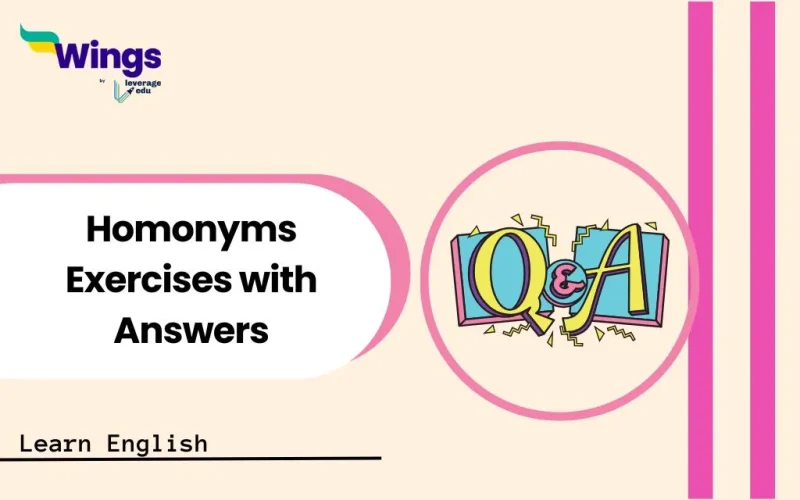Homonyms—words that sound alike but have different meanings—can often cause confusion in writing and speech. Do you struggle with words like “bare” and “bear” or “flour” and “flower”? How can you ensure you’re using the right word in the right context? Mastering homonyms enhances vocabulary, improves communication, and sharpens grammar skills. This blog provides Homonyms Exercises with Answers to help learners practice and gain confidence. Ready to test your knowledge? Let’s get started!
This Blog Includes:
What are Homonyms?
A homonym is a word that shares the same spelling or pronunciation with another word but has a different meaning. It is crucial to understand what homonyms are as they help expand your vocabulary and improve your ability to use language effectively. Homonyms are often used in puns, jokes, and other forms of wordplay, adding humour and creativity to language.
Let us look at some of the examples of homonyms:
| Homonyms | Meaning 1 | Meaning 2 |
| Bow | To bend at the waist. | The front of a ship. |
| Lead | A heavy metal | To guide |
| Record | To write down information | A vinyl disk |
Also Read: Homophone vs Homonym vs Homograph
Homonyms Exercises with Answers
Exercise 1: Fill in the Blanks (Homophones)
Instructions: Choose the correct word to complete each sentence.
- I don’t know _____ (whether/weather) we should go outside.
- They’re going to _____ (write/right) a letter.
- Do you _____ (know/no) the answer?
- The ship sailed across the _____ (sea/see).
- Please sit _____ (here/hear).
Answers:
- whether
- write
- know
- sea
- here
Exercise 2: Multiple Choice (Homographs)
Instructions: Choose the correct meaning of the underlined word.
- She had to tear the paper.
- a) a drop of liquid from the eye
- b) to rip
- The bass was playing loudly.
- a) a type of fish
- b) a low-frequency sound
- He wanted to present a gift.
- a) to show
- b) a gift
- The dove was a symbol of peace.
- a) a state of calm.
- b) to make quiet.
- He had to polish the silver.
- a) someone from Poland.
- b) to make shine.
Answers:
- b) to rip
- b) a low-frequency sound
- a) to show
- a) a state of calm.
- b) to make shine.
Exercise 3: Matching Pairs (Homophones)
Instructions: Match the words with their correct meanings.
| Pair | Fruit |
| Pear | b) A cloth used to propel a boat |
| Sale | c) Two-of-a-kind |
| Sail | d) A reduction in price |
| Plain | e) Simple or a flat area |
Answers:
- c) Tow of a Kind
- a) Fruit
- d) A reduction in price
- b)A cloth used to propel a boat
- e) Simple or a flat area
Exercise 4: Sentence Creation
Instructions: Create two sentences for each word, using its different meanings.
- Rose
- a.
- b.
- Minute
- a.
- b.
Answers:
- Rose
- a. She was given a red rose.
- b. The sun rose early this morning.
- Minute
- a. Please wait a minute.
- b. The minute details were hard to see.
Exercise 5: True or False
Instructions: Determine if the following statements are true or false.
- The words “flour” and “flower” are homographs.
- The words “read” (present tense) and “read” (past tense) are homographs.
- All homophones have different spellings.
- The word “bank” only has one meaning.
- “fair” and “fare” are Homophones.
Answers:
- False
- True
- True
- False
- True.
Also Read: Homophone vs Homonym: Key Differences & Examples
Homonyms Exercises (Free Worksheet)
To help you master this topic, we have prepared this worksheet for you which will be quite helpful for you. You can easily save and download this worksheet for future reference. You can check your performance at the end of this worksheet.
Check Answers:
- Well
- The little girl felt well after taking her medicine. (Meaning: in good health)
- We collected water from the well in the ground. (Meaning: a deep hole in the ground from which water is drawn)
- Right
- Turn right at the next intersection. (Meaning: direction)
- You are right about the answer. (Meaning: correct)
- Bark
- The dog gave a loud bark. (Meaning: the sound a dog makes)
- The bark of the tree was rough. (Meaning: the outer layer of a tree)
- Palm
- She held the bird gently in the palm of her hand. (Meaning: the inner surface of the hand)
- We relaxed under the shade of the palm tree. (Meaning: a type of tree)
- Rose
- She received a beautiful red rose. (Meaning: a type of flower)
- The sun rose early this morning. (Meaning: to get up or ascend)
Also Read: What are Homophones?
Bonus Homonyms Exercise with Answers
Instructions: Read each sentence and determine the meaning of the underlined homonym based on the context. Then, provide a different sentence using the other meaning of the same homonym.
- Sentence: The carpenter used a plane to smooth the wood.
- Meaning of “plane”: A tool used for smoothing wood.
- New Sentence: ____________________________________________________
- Sentence: The boxer threw a powerful punch.
- Meaning of “punch”: A blow with the fist.
- New Sentence: ____________________________________________________
- Sentence: The audience gave a loud cheer.
- Meaning of “cheer”: A shout of encouragement or approval.
- New Sentence: ____________________________________________________
- Sentence: The river bank was eroded by the flood.
- Meaning of “bank”: The land alongside a river.
- New Sentence: ____________________________________________________
- Sentence: He had to address the envelope before mailing it.
- Meaning of “address”: To write the recipient’s details on an envelope or package.
- New Sentence: ____________________________________________________
Answers:
- Sentence: The carpenter used a plane to smooth the wood.
- Meaning of “plane”: A tool used for smoothing wood.
- New Sentence: The plane took off on time. (Or: The geometric plane was explained in math class.)
- Sentence: The boxer threw a powerful punch.
- Meaning of “punch”: A blow with the fist.
- New Sentence: I’d like a fruit punch, please. (Or: The hole punch made neat circles.)
- Sentence: The audience gave a loud cheer.
- Meaning of “cheer”: A shout of encouragement or approval.
- New Sentence: Let’s cheer up and watch a funny movie. (Or: She added a cheer to the end of her email.)
- Sentence: The river bank was eroded by the flood.
- Meaning of “bank”: The land alongside a river.
- New Sentence: I deposited money at the bank. (Or: The plane made a sharp bank to the right.)
- Sentence: He had to address the envelope before mailing it.
- Meaning of “address”: To write the recipient’s details on an envelope or package.
- New Sentence: The speaker will address the audience after the introduction. (Or: Please address your concerns to the manager.)
Explore similar blogs on Learn English here:
FAQs
Homonyms are words that sound alike or are spelled alike, but have different meanings. They can be spelled the same (like “bear” the animal and “bear” to endure) or differently (like “to,” “too,” and “two”).
Homonym exercises are important because they help improve vocabulary, reading comprehension, and writing accuracy. They reduce the chance of misunderstandings caused by using the wrong word.
Fill-in-the-blank sentences: Choosing the correct homonym to complete a sentence.
Multiple-choice questions: Selecting the right homonym from a list of options.
Sentence creation: Writing sentences that demonstrate the different meanings of a given homonym.
Identifying homonyms in a text: Finding and explaining the meanings of homonyms within a passage.
Match the following: Matching homonyms to their definitions.
Use games and puzzles: Incorporate homonyms into word searches, crosswords, or online games.
Create real-life scenarios: Ask learners to use homonyms in everyday conversations or writing tasks.
Use visual aids: Employ pictures or illustrations to represent the different meanings of homonyms.
Use digital applications that have interactive homonym games.
Distinguishing between similar-sounding words: It can be difficult to remember the subtle differences in meaning.
Understanding context: Knowing which homonym to use depends heavily on the surrounding words and the overall meaning of the sentence.
Confusion with homophones vs homographs: it is hard to remember the difference between those.
Homophones sound the same but have different spellings.
Homographs: same spelling, different sound.
Educational websites: Many websites offer free homonym worksheets, quizzes, and games.
Language learning apps: Apps like those for learning English often have sections dedicated to homonyms.
Textbooks and workbooks: English language textbooks and workbooks often include homonym exercises.
Online search engines: searching for “homonym exercises” will provide many resources.
We hope this blog on “Homonyms Exercises with Answers” helped you improve your English skills. You can also follow the Learn English page of Leverage Edu for more exciting and informative blogs related to English grammar and the English language
 One app for all your study abroad needs
One app for all your study abroad needs















 45,000+ students trusted us with their dreams. Take the first step today!
45,000+ students trusted us with their dreams. Take the first step today!


